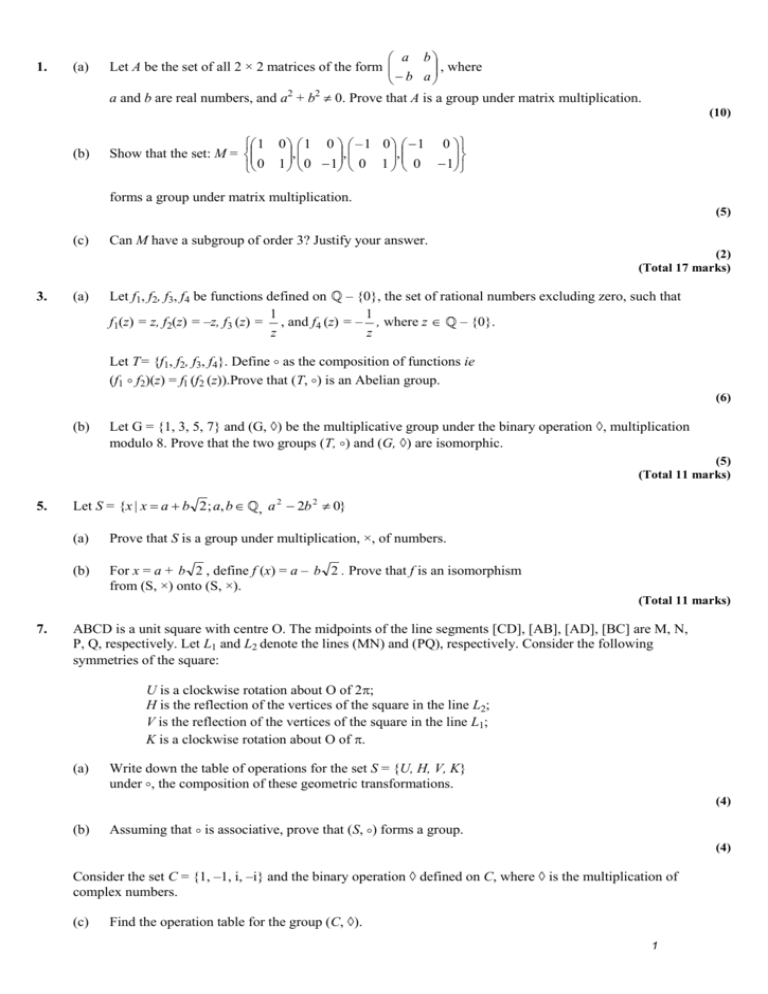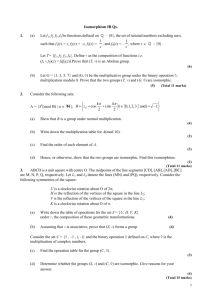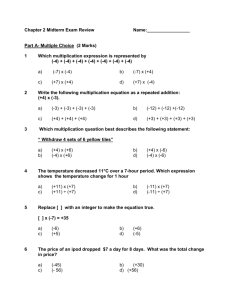OptGrAxiomPrQ
advertisement

1.
(a)
a b
, where
Let A be the set of all 2 × 2 matrices of the form
b a
a and b are real numbers, and a2 + b2 0. Prove that A is a group under matrix multiplication.
(10)
(b)
1 0 1 0 – 1 0 1 0
,
,
,
Show that the set: M =
0 1 0 1 0 1 0 1
forms a group under matrix multiplication.
(5)
(c)
Can M have a subgroup of order 3? Justify your answer.
(2)
(Total 17 marks)
3.
(a)
Let f1, f2, f3, f4 be functions defined on – {0}, the set of rational numbers excluding zero, such that
1
1
f1(z) = z, f2(z) = –z, f3 (z) = , and f4 (z) = – , where z – {0}.
z
z
Let T= {f1, f2, f3, f4}. Define as the composition of functions ie
(f1 f2)(z) = fl (f2 (z)).Prove that (T, ) is an Abelian group.
(6)
(b)
Let G = {1, 3, 5, 7} and (G, ) be the multiplicative group under the binary operation , multiplication
modulo 8. Prove that the two groups (T, ) and (G, ) are isomorphic.
(5)
(Total 11 marks)
5.
Let S = {x | x a b 2 ; a, b , a 2 2b 2 0}
(a)
Prove that S is a group under multiplication, ×, of numbers.
(b)
For x = a + b 2 , define f (x) = a – b 2 . Prove that f is an isomorphism
from (S, ×) onto (S, ×).
(Total 11 marks)
7.
ABCD is a unit square with centre O. The midpoints of the line segments [CD], [AB], [AD], [BC] are M, N,
P, Q, respectively. Let L1 and L2 denote the lines (MN) and (PQ), respectively. Consider the following
symmetries of the square:
U is a clockwise rotation about O of 2;
H is the reflection of the vertices of the square in the line L2;
V is the reflection of the vertices of the square in the line L1;
K is a clockwise rotation about O of .
(a)
Write down the table of operations for the set S = {U, H, V, K}
under , the composition of these geometric transformations.
(4)
(b)
Assuming that is associative, prove that (S, ) forms a group.
(4)
Consider the set C = {1, –1, i, –i} and the binary operation defined on C, where is the multiplication of
complex numbers.
(c)
Find the operation table for the group (C, ).
1
(3)
(d)
Determine whether the groups (S, ) and (C, ) are isomorphic. Give reasons for your answer.
(4)
(Total 15 marks)
9.
Let (S, °) be the group of all permutations of four elements a, b, c, d. The permutation that maps a onto c, b
onto d, c onto a and d onto b is represented by
a b c d
.
c d a b
a b c d
.
a b c d
The identity element is represented by
Note that AB denotes the permutation obtained when permutation B is followed by permutation A.
(a)
a b c d
.
c a d b
Find the inverse of the permutation
(1)
(b)
Find a subgroup of S of order 2.
(2)
(c)
Find a subgroup of S of order 4, showing that it is a subgroup of S.
(7)
(Total 10 marks)
11.
Let S = {f, g, h, j} be the set of functions defined by
f (x) = x, g (x) = –x, h (x) =
(a)
1
1
, j (x) = – , where x 0.
x
x
Construct the operation table for the group {S,°}, where ° is the composition of functions.
(3)
(b)
The following are the operation tables for the groups {0, 1, 2, 3} under addition modulo 4, and {1, 2,
3, 4} under multiplication modulo 5.
+
0
1
2
3
×
1
2
3
4
0
0
1
2
3
1
1
2
3
4
1
1
2
3
0
2
2
4
1
3
2
2
3
0
1
3
3
1
4
2
3
3
0
1
2
4
4
3
2
1
By comparing the elements in the two tables given plus the table constructed in part (a), find which groups
are isomorphic. Give reasons for your answers. State clearly the corresponding elements.
(6)
(Total 9 marks)
13.
Let S be the set of all (2 × 2) non-singular matrices each of whose elements is either 0 or 1. Two matrices
belonging to S are
0 1
1 1
and
.
1 0
0 1
2
(a)
Write down the other four members of S.
(4)
(b)
You are given that S forms a group under matrix multiplication, when the elements of the matrix
product are calculated modulo 2.
(i)
Find the order of all the members of S whose determinant is negative.
(ii)
Hence find a subgroup of S of order 3.
(6)
(Total 10 marks)
15.
Consider the set S = {1, 3, 4, 9, 10, 12} on which the operation is defined as multiplication modulo 13.
(a)
Write down the operation table for S under .
(4)
(b)
Assuming multiplication modulo 13 is associative, show that (S, ) is a commutative group.
(4)
(c)
State the order of each element.
(3)
(d)
Find all the subgroups of (S, )
(3)
(Total 14 marks)
17.
x 2
x
such that det T = 1.
Let the matrix T be defined by
x 5 x
(a)
(i)
Show that the equation for x is 2x2 – 3x – 9 = 0.
(ii)
The solutions of this equation are a and b, where a > b.
Find a and b.
(5)
(b)
Let A be the matrix where x = 3
(i)
Find A2.
(ii)
Assuming that matrix multiplication is associative, find the smallest group of 2 × 2 matrices
which contains A, showing clearly that this is a group.
(6)
(Total 11 marks)
19.
Consider the binary operation a divided by b defined on
group axioms is satisfied.
+
. Determine whether or not each of the four
(Total 7 marks)
21.
The order of each of the elements of the group (G, * ) is either 1 or 2. Show that G is an Abelian group.
(Total 7 marks)
23.
The permutations p1 and p2 of the integers {1, 2, 3, 4, 5} are given by
1 2 3 4 5
1 2 3 4 5
; p 2
.
p1
3 1 2 5 4
2 3 4 5 1
(a)
Find the order of p1.
(4)
3
(b)
(i)
Find p2 p1, the composite permutation p1 followed by p2.
(ii)
Determine whether or not p1 and p2 commute under composition of permutations.
(4)
(c)
Find (p12 p2)–1.
(4)
(Total 12 marks)
25.
(a)
a b
; a, b
b a
Show that the set M =
, a 2 b 2 0 together with matrix
multiplication ( ) forms a group {M, }.
(6)
(b)
Find an isomorphism from the multiplicative group of non-zero complex numbers to the group {M,
}. Justify your answer.
(8)
(Total 14 marks)
27.
(a)
The relation R is defined for x, y
+
such that xRy if and only if 3x 3y (mod10).
(i)
Show that R is an equivalence relation.
(ii)
Identify all the equivalence classes.
(11)
(b)
Let S denote the set x x a b 3, a, b
, a2 + b2 0.
(i)
Prove that S is a group under multiplication.
(ii)
Give a reason why S would not be a group if the conditions on a, b were changed to a, b
+ b2 0.
, a2
(15)
(Total 26 marks)
29.
The binary operation * is defined for a, b
+
by
a * b = a + b − 2.
(a)
Determine whether or not * is
(i)
closed,
(ii)
commutative,
(iii)
associative.
(7)
(b)
(i)
Find the identity element.
(ii)
Find the set of positive integers having an inverse under *.
(5)
(Total 12 marks)
31.
(a)
Draw the Cayley table for the set of integers G = 0, 1, 2, 3, 4, 5 under addition modulo 6, +6.
(3)
(b)
Show that G, 6 is a group.
4
(4)
(c)
Find the order of each element.
(3)
(d)
Show that G, 6 is cyclic and state its generators.
(2)
(e)
Find a subgroup with three elements.
(2)
(f)
Find the other proper subgroups of G, 6 .
(2)
(Total 16 marks)
5









